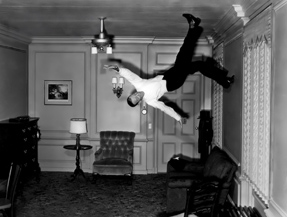Classic Movie Review: Royal Wedding
By Josh Spiegel
December 15, 2010
BoxOfficeProphets.com

As with any of the old MGM musicals, Royal Wedding has a simple enough story. Astaire and Jane Powell play a brother-and-sister dancing duo who go across the pond to London to perform at the upcoming royal wedding of Princess Elizabeth and Prince Philip (the film is set in 1947). While there, they fall in love with very different people, get into various romantic scrapes, but end up living happily ever after. You can call that a spoiler alert if you like, but if you’ve ever seen, you know, a movie, you shouldn’t be surprised about where the plot of this film is going. What makes Royal Wedding so notable is its dance sequences, some with both Astaire and Powell — the most impressive set piece with the two of them comes on the ship they take to London — and one with Astaire and some zero-gravity-style tricks.
Fred Astaire was the gentleman of dance in the golden age of Hollywood musicals. Gene Kelly was more of a sneaky, winking Puck of a dancer; watch his Moses Supposes duet with Donald O’Connor in the middle of Singin’ In The Rain, and it’s hard not to see him metaphorically jabbing his elbow in your ribs, making sure you just saw what he did. It was rare for Astaire to physically explode in dance, though there is one great example. In his duet with Eleanor Powell in Broadway Melody of 1940 — an amazing feat of tap-dancing combined with appropriately simple direction from Norman Taurog — the two dance to Begin the Beguine, and there’s a point midway through where the music hits a quick crescendo, and his whole body seems to expand from its typically understated pose. There’s something breathtaking about the whole sequence, but in general, Astaire kept his eyes on just being a great tap-dancer.
This doesn’t mean Astaire wasn’t capable of jaw-dropping twists in his dancing. The sequence everyone thinks of when they think of Fred Astaire dancing solo comes from this film, where he’s so besotted with a young woman that he dances in his hotel room, from one side of the floor to the other, and then right up to the wall and ceiling, all in one take. The sequence is truly memorable, a great reason why dance in film shouldn’t be pushed aside when it’s done right. The technical proficiency in the scene — not just from Astaire, but from the mechanics of making it look like Astaire’s actually on the ceiling — is amazing, but there’s a reason for the scene to exist aside from just being really cool. As it goes with pretty much every MGM musical, there is some romantic melodrama, but who cares when you can watch Fred Astaire?
Most of Astaire’s esteemed career is boiled down to his time with Ginger Rogers in such films as Top Hat and Swing Time. That said, he managed to make an impression by himself for years afterward, with romantic leads as notable as Judy Garland (in Easter Parade). Here, though, the real chemistry Astaire has isn’t with the woman playing his paramour, Sarah Churchill, but with the actress playing his sister, Jane Powell. What’s most immediately striking about Powell is not that she is beautiful; plenty of actresses were in this time. Powell, though, is beautiful in a very modern way, spritely, prankish, spunky, and also very pretty. In her various scenes, both with Astaire and the actor playing her new man, future Rat Packer Peter Lawford, Powell shines most when she’s riffing with Astaire off the dance floor.
This is, in essence, the issue with any movie starring Fred Astaire, as opposed to Gene Kelly. For whatever reason, while both men are amazing dancers, unparalleled in their craft and charisma, Astaire’s affable nature dissipates a bit when he’s not tapping a rhythm. Gene Kelly dances superlatively in Singin’ In The Rain, but the film is also a trenchantly witty movie about making movies with plenty of great gags and one-liners (“Why, I make more money than…Calvin Coolidge! PUT TOGETHER!”), sweet songs, and entertaining performances. Kelly was also in the almost-as-great An American in Paris, replete with a climactic dance sequence but also featuring great characters and a compelling romance. Fred Astaire is a great dancer and a good actor, but he wasn’t able to find someone as equal to him as Ginger Rogers, to the detriment of his future work.
Royal Wedding’s not a bad movie, mind you. If you enjoy MGM-era material, you’ll find a lot to like here, but after a while, if you’ve heard the same notes, it’s not so compelling to hear them rearranged. Fred Astaire is always going to be one of the best dancers of all time, and as a screen presence, he was relatively commanding. As an actor, he was watchable, but none of his films were as adventurous and brave as the dances he’d perform on screen. Both he and Kelly are memorable figures in the world of film and dance, marrying the two art forms, but only Kelly had the insight to make the movies about more than just dancing. You can watch An American in Paris as a great film, or as a great work of dance. Royal Wedding is charming and cute and light, and if it wasn’t for Astaire dancing on the ceiling, we’d have forgotten it long ago if not for Turner Classic Movies.